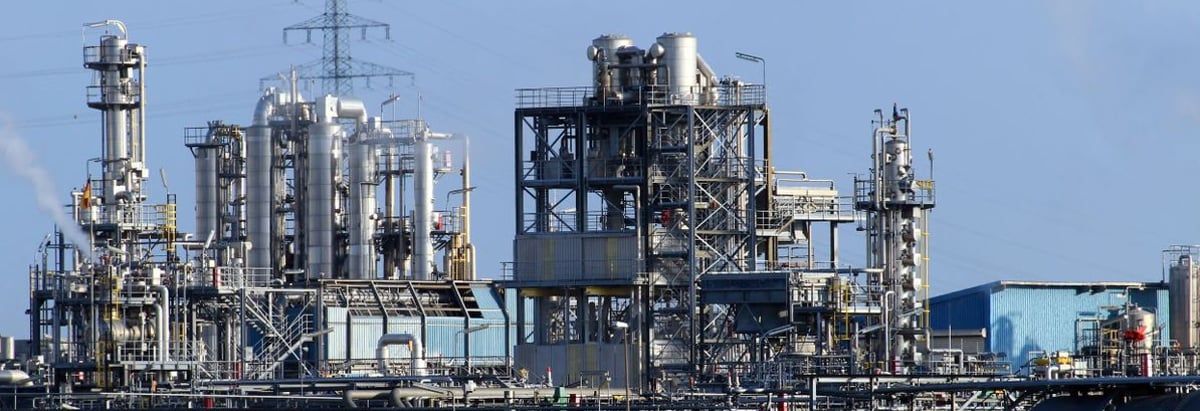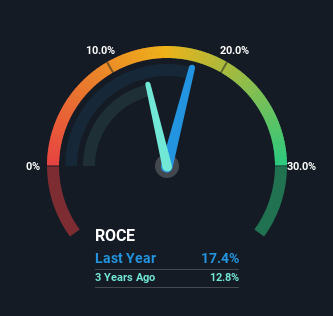Stock Analysis
- India
- /
- Oil and Gas
- /
- NSEI:MRPL
Some Investors May Be Worried About Mangalore Refinery and Petrochemicals' (NSE:MRPL) Returns On Capital

What underlying fundamental trends can indicate that a company might be in decline? More often than not, we'll see a declining return on capital employed (ROCE) and a declining amount of capital employed. Basically the company is earning less on its investments and it is also reducing its total assets. So after we looked into Mangalore Refinery and Petrochemicals (NSE:MRPL), the trends above didn't look too great.
What is Return On Capital Employed (ROCE)?
For those that aren't sure what ROCE is, it measures the amount of pre-tax profits a company can generate from the capital employed in its business. Analysts use this formula to calculate it for Mangalore Refinery and Petrochemicals:
Return on Capital Employed = Earnings Before Interest and Tax (EBIT) ÷ (Total Assets - Current Liabilities)
0.17 = ₹38b ÷ (₹401b - ₹180b) (Based on the trailing twelve months to March 2022).
So, Mangalore Refinery and Petrochemicals has an ROCE of 17%. On its own, that's a standard return, however it's much better than the 11% generated by the Oil and Gas industry.
Check out our latest analysis for Mangalore Refinery and Petrochemicals

Historical performance is a great place to start when researching a stock so above you can see the gauge for Mangalore Refinery and Petrochemicals' ROCE against it's prior returns. If you'd like to look at how Mangalore Refinery and Petrochemicals has performed in the past in other metrics, you can view this free graph of past earnings, revenue and cash flow.
So How Is Mangalore Refinery and Petrochemicals' ROCE Trending?
In terms of Mangalore Refinery and Petrochemicals' historical ROCE movements, the trend doesn't inspire confidence. About five years ago, returns on capital were 22%, however they're now substantially lower than that as we saw above. Meanwhile, capital employed in the business has stayed roughly the flat over the period. Since returns are falling and the business has the same amount of assets employed, this can suggest it's a mature business that hasn't had much growth in the last five years. If these trends continue, we wouldn't expect Mangalore Refinery and Petrochemicals to turn into a multi-bagger.
On a side note, Mangalore Refinery and Petrochemicals' current liabilities are still rather high at 45% of total assets. This can bring about some risks because the company is basically operating with a rather large reliance on its suppliers or other sorts of short-term creditors. While it's not necessarily a bad thing, it can be beneficial if this ratio is lower.
In Conclusion...
In the end, the trend of lower returns on the same amount of capital isn't typically an indication that we're looking at a growth stock. Investors haven't taken kindly to these developments, since the stock has declined 28% from where it was five years ago. That being the case, unless the underlying trends revert to a more positive trajectory, we'd consider looking elsewhere.
One more thing to note, we've identified 2 warning signs with Mangalore Refinery and Petrochemicals and understanding them should be part of your investment process.
For those who like to invest in solid companies, check out this free list of companies with solid balance sheets and high returns on equity.
Valuation is complex, but we're helping make it simple.
Find out whether Mangalore Refinery and Petrochemicals is potentially over or undervalued by checking out our comprehensive analysis, which includes fair value estimates, risks and warnings, dividends, insider transactions and financial health.
View the Free AnalysisHave feedback on this article? Concerned about the content? Get in touch with us directly. Alternatively, email editorial-team (at) simplywallst.com.
This article by Simply Wall St is general in nature. We provide commentary based on historical data and analyst forecasts only using an unbiased methodology and our articles are not intended to be financial advice. It does not constitute a recommendation to buy or sell any stock, and does not take account of your objectives, or your financial situation. We aim to bring you long-term focused analysis driven by fundamental data. Note that our analysis may not factor in the latest price-sensitive company announcements or qualitative material. Simply Wall St has no position in any stocks mentioned.
About NSEI:MRPL
Mangalore Refinery and Petrochemicals
Manufactures and sells refined petroleum products in India.
Solid track record with excellent balance sheet and pays a dividend.

